Comprehensive Report: Pharmaceutical Benefit Scheme in Australia (PBS)
VerifiedAdded on 2023/01/20
|12
|2530
|59
Report
AI Summary
This report provides a comprehensive analysis of the Pharmaceutical Benefit Scheme (PBS) in Australia, examining its role in the country's healthcare system. It explores the increasing consumption of medicines and the corresponding rise in pharmaceutical expenditure. The report delves into the features of the PBS, which offers subsidized medicines to Australian residents and some foreign visitors. It discusses the health expenditure of the Australian government, highlighting the funds allocated to the PBS and other healthcare sectors. The types of medicines consumed under the PBS are outlined, along with the sources of funding for the scheme. The report also presents recommendations for improving the PBS, such as cost reduction strategies and enhancing patient benefits. The conclusion emphasizes the PBS's effectiveness while suggesting areas for improvement to reduce the financial burden on the economy and maintain quality healthcare.
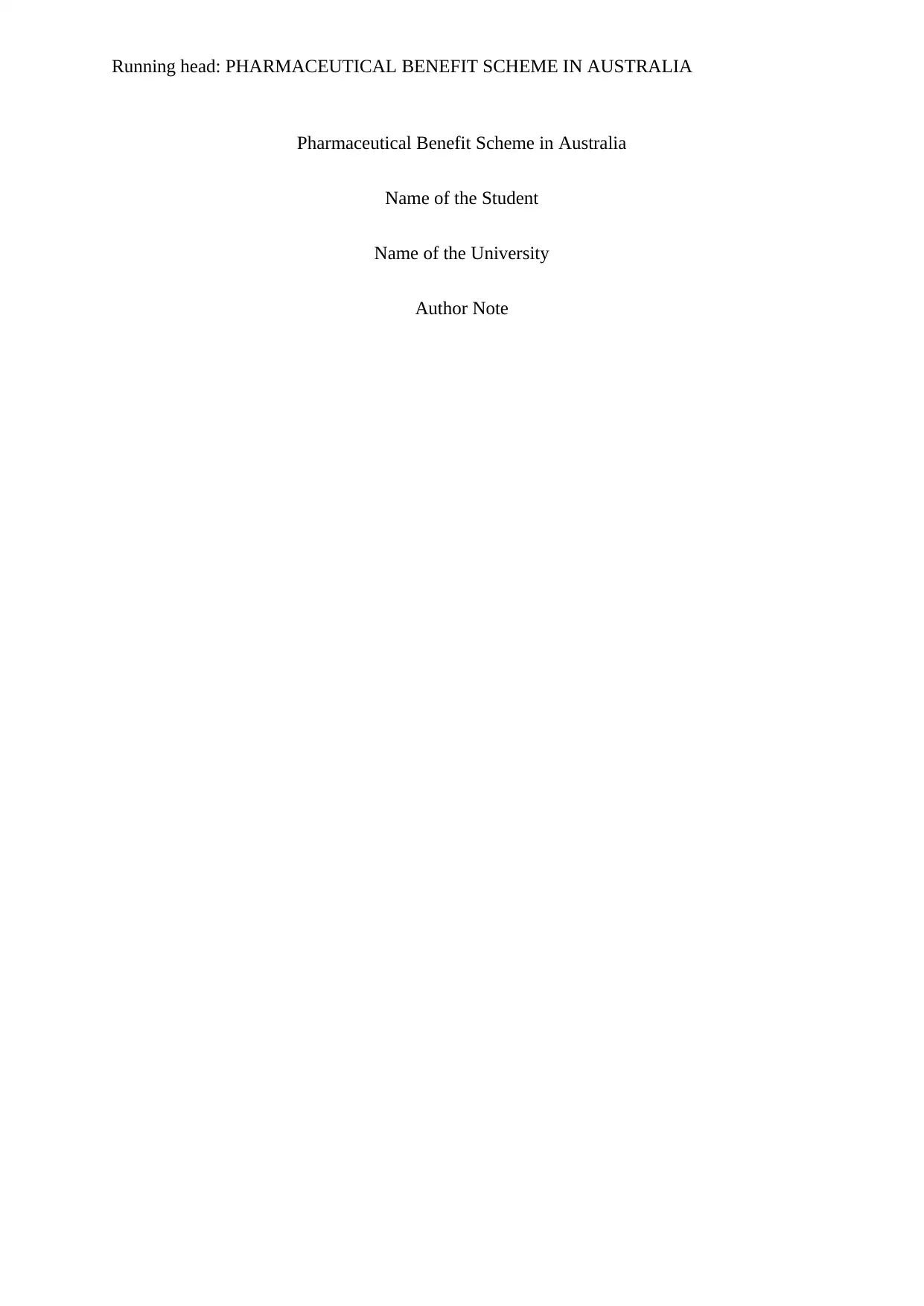
Running head: PHARMACEUTICAL BENEFIT SCHEME IN AUSTRALIA
Pharmaceutical Benefit Scheme in Australia
Name of the Student
Name of the University
Author Note
Pharmaceutical Benefit Scheme in Australia
Name of the Student
Name of the University
Author Note
Paraphrase This Document
Need a fresh take? Get an instant paraphrase of this document with our AI Paraphraser
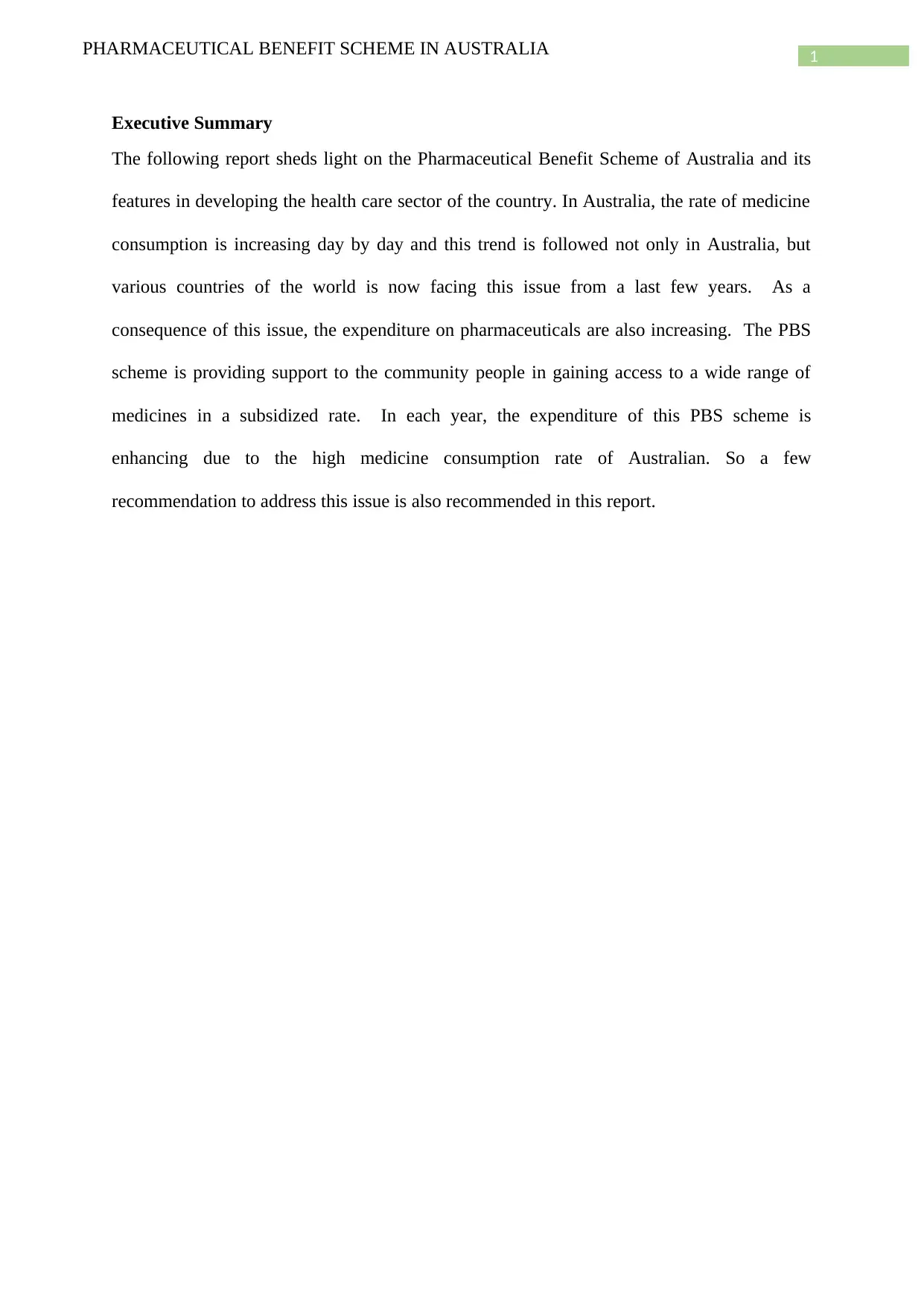
1PHARMACEUTICAL BENEFIT SCHEME IN AUSTRALIA
Executive Summary
The following report sheds light on the Pharmaceutical Benefit Scheme of Australia and its
features in developing the health care sector of the country. In Australia, the rate of medicine
consumption is increasing day by day and this trend is followed not only in Australia, but
various countries of the world is now facing this issue from a last few years. As a
consequence of this issue, the expenditure on pharmaceuticals are also increasing. The PBS
scheme is providing support to the community people in gaining access to a wide range of
medicines in a subsidized rate. In each year, the expenditure of this PBS scheme is
enhancing due to the high medicine consumption rate of Australian. So a few
recommendation to address this issue is also recommended in this report.
Executive Summary
The following report sheds light on the Pharmaceutical Benefit Scheme of Australia and its
features in developing the health care sector of the country. In Australia, the rate of medicine
consumption is increasing day by day and this trend is followed not only in Australia, but
various countries of the world is now facing this issue from a last few years. As a
consequence of this issue, the expenditure on pharmaceuticals are also increasing. The PBS
scheme is providing support to the community people in gaining access to a wide range of
medicines in a subsidized rate. In each year, the expenditure of this PBS scheme is
enhancing due to the high medicine consumption rate of Australian. So a few
recommendation to address this issue is also recommended in this report.
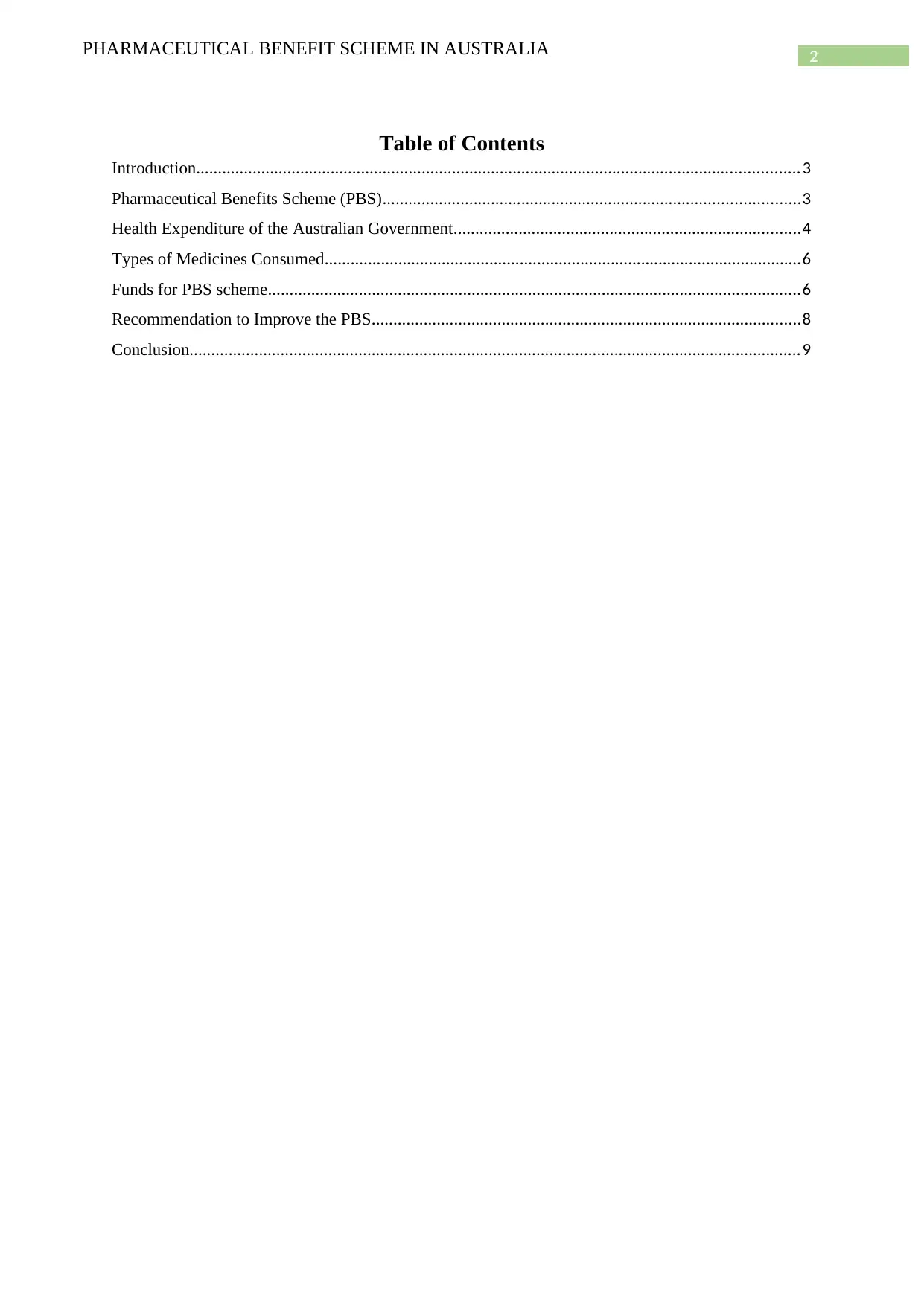
2PHARMACEUTICAL BENEFIT SCHEME IN AUSTRALIA
Table of Contents
Introduction...........................................................................................................................................3
Pharmaceutical Benefits Scheme (PBS)................................................................................................3
Health Expenditure of the Australian Government................................................................................4
Types of Medicines Consumed..............................................................................................................6
Funds for PBS scheme...........................................................................................................................6
Recommendation to Improve the PBS...................................................................................................8
Conclusion.............................................................................................................................................9
Table of Contents
Introduction...........................................................................................................................................3
Pharmaceutical Benefits Scheme (PBS)................................................................................................3
Health Expenditure of the Australian Government................................................................................4
Types of Medicines Consumed..............................................................................................................6
Funds for PBS scheme...........................................................................................................................6
Recommendation to Improve the PBS...................................................................................................8
Conclusion.............................................................................................................................................9
⊘ This is a preview!⊘
Do you want full access?
Subscribe today to unlock all pages.

Trusted by 1+ million students worldwide

3PHARMACEUTICAL BENEFIT SCHEME IN AUSTRALIA
Introduction
In Australia, the rate of medicine consumption is increasing day by day and this trend
is followed not only in Australia, but various countries of the world is now facing this issue
from a last few years. As a consequence of this issue, the expenditure on pharmaceuticals are
increasing too. In Australia, the consumption of both drugs that is legal and illegal drugs has
enhanced in last two years (Malik et al., 2018). From the report of the Australian Government
it is noted that, the use of prescribed drugs and non-prescribed drugs are enhancing the
burden of the Pharmaceutical Benefits Scheme (PBS). This scheme is providing support to
the community people in gaining access to a wide range of medicines in a subsidized rates
since 1950. Along with the residents of Australia, this scheme also provides this facility to
certain foreign visitors as well by using the Reciprocal Health Care Agreement. The PBS is
mainly aiming to provide medicines to those who are living in isolated areas of the country
(Laba et al., 2015). In each year, the expenditure of this PBS scheme is enhancing due to the
high medicine consumption rate of Australian (Knott et al., 2015). In this report, the PBS
scheme, expenditure of Australian people on medicine, the reason of this increasing
expenditure of the country are discussed. In addition to this, a few problems related to the
consumption of prescribed and non-prescribed medicines is also highlighted.
Pharmaceutical Benefits Scheme (PBS)
The PBS scheme is one of the defining features of the Australian health care system.
By using a medical card the residents of the Australia can access the advantages of subsidized
medicines. The patients or the consumers pay only a set of price for availing this services.
The amount is approximately, $36.90 for the general patients and $6.00 for the patients who
have concession cards. In this scheme, most of the medicines are given through the
community dispensaries and only a few medicines are distributed through the hospitals of the
Introduction
In Australia, the rate of medicine consumption is increasing day by day and this trend
is followed not only in Australia, but various countries of the world is now facing this issue
from a last few years. As a consequence of this issue, the expenditure on pharmaceuticals are
increasing too. In Australia, the consumption of both drugs that is legal and illegal drugs has
enhanced in last two years (Malik et al., 2018). From the report of the Australian Government
it is noted that, the use of prescribed drugs and non-prescribed drugs are enhancing the
burden of the Pharmaceutical Benefits Scheme (PBS). This scheme is providing support to
the community people in gaining access to a wide range of medicines in a subsidized rates
since 1950. Along with the residents of Australia, this scheme also provides this facility to
certain foreign visitors as well by using the Reciprocal Health Care Agreement. The PBS is
mainly aiming to provide medicines to those who are living in isolated areas of the country
(Laba et al., 2015). In each year, the expenditure of this PBS scheme is enhancing due to the
high medicine consumption rate of Australian (Knott et al., 2015). In this report, the PBS
scheme, expenditure of Australian people on medicine, the reason of this increasing
expenditure of the country are discussed. In addition to this, a few problems related to the
consumption of prescribed and non-prescribed medicines is also highlighted.
Pharmaceutical Benefits Scheme (PBS)
The PBS scheme is one of the defining features of the Australian health care system.
By using a medical card the residents of the Australia can access the advantages of subsidized
medicines. The patients or the consumers pay only a set of price for availing this services.
The amount is approximately, $36.90 for the general patients and $6.00 for the patients who
have concession cards. In this scheme, most of the medicines are given through the
community dispensaries and only a few medicines are distributed through the hospitals of the
Paraphrase This Document
Need a fresh take? Get an instant paraphrase of this document with our AI Paraphraser
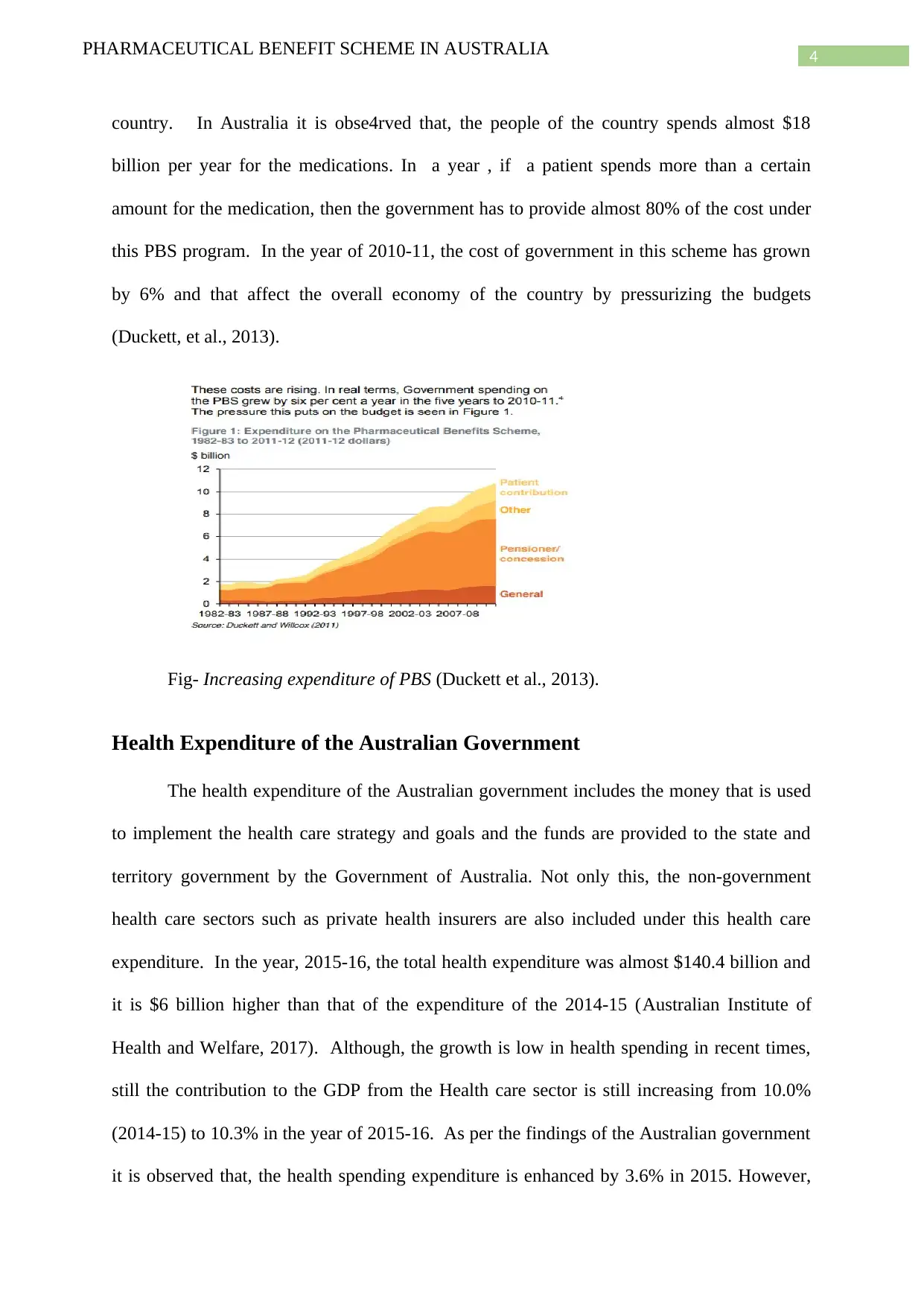
4PHARMACEUTICAL BENEFIT SCHEME IN AUSTRALIA
country. In Australia it is obse4rved that, the people of the country spends almost $18
billion per year for the medications. In a year , if a patient spends more than a certain
amount for the medication, then the government has to provide almost 80% of the cost under
this PBS program. In the year of 2010-11, the cost of government in this scheme has grown
by 6% and that affect the overall economy of the country by pressurizing the budgets
(Duckett, et al., 2013).
Fig- Increasing expenditure of PBS (Duckett et al., 2013).
Health Expenditure of the Australian Government
The health expenditure of the Australian government includes the money that is used
to implement the health care strategy and goals and the funds are provided to the state and
territory government by the Government of Australia. Not only this, the non-government
health care sectors such as private health insurers are also included under this health care
expenditure. In the year, 2015-16, the total health expenditure was almost $140.4 billion and
it is $6 billion higher than that of the expenditure of the 2014-15 (Australian Institute of
Health and Welfare, 2017). Although, the growth is low in health spending in recent times,
still the contribution to the GDP from the Health care sector is still increasing from 10.0%
(2014-15) to 10.3% in the year of 2015-16. As per the findings of the Australian government
it is observed that, the health spending expenditure is enhanced by 3.6% in 2015. However,
country. In Australia it is obse4rved that, the people of the country spends almost $18
billion per year for the medications. In a year , if a patient spends more than a certain
amount for the medication, then the government has to provide almost 80% of the cost under
this PBS program. In the year of 2010-11, the cost of government in this scheme has grown
by 6% and that affect the overall economy of the country by pressurizing the budgets
(Duckett, et al., 2013).
Fig- Increasing expenditure of PBS (Duckett et al., 2013).
Health Expenditure of the Australian Government
The health expenditure of the Australian government includes the money that is used
to implement the health care strategy and goals and the funds are provided to the state and
territory government by the Government of Australia. Not only this, the non-government
health care sectors such as private health insurers are also included under this health care
expenditure. In the year, 2015-16, the total health expenditure was almost $140.4 billion and
it is $6 billion higher than that of the expenditure of the 2014-15 (Australian Institute of
Health and Welfare, 2017). Although, the growth is low in health spending in recent times,
still the contribution to the GDP from the Health care sector is still increasing from 10.0%
(2014-15) to 10.3% in the year of 2015-16. As per the findings of the Australian government
it is observed that, the health spending expenditure is enhanced by 3.6% in 2015. However,
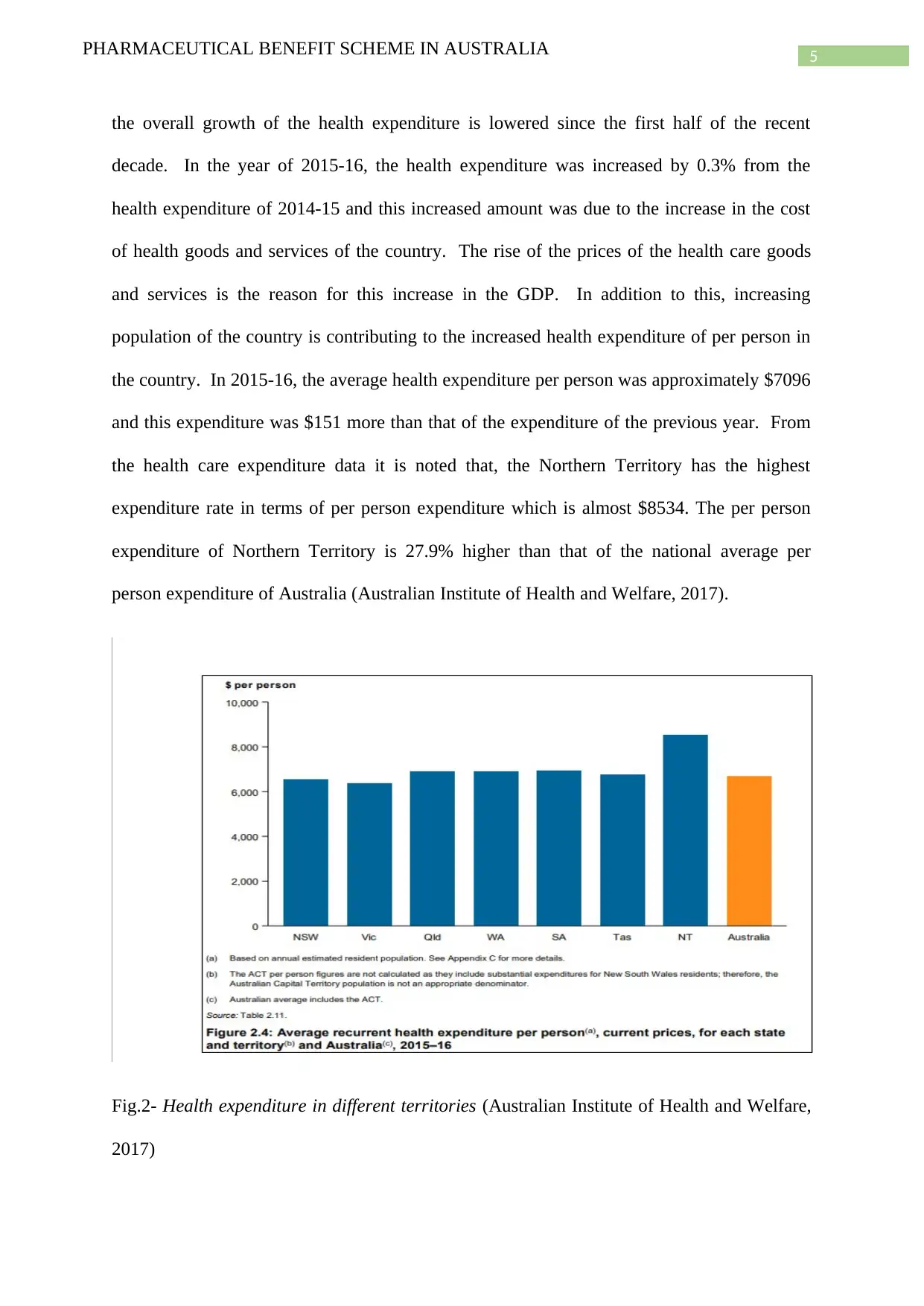
5PHARMACEUTICAL BENEFIT SCHEME IN AUSTRALIA
the overall growth of the health expenditure is lowered since the first half of the recent
decade. In the year of 2015-16, the health expenditure was increased by 0.3% from the
health expenditure of 2014-15 and this increased amount was due to the increase in the cost
of health goods and services of the country. The rise of the prices of the health care goods
and services is the reason for this increase in the GDP. In addition to this, increasing
population of the country is contributing to the increased health expenditure of per person in
the country. In 2015-16, the average health expenditure per person was approximately $7096
and this expenditure was $151 more than that of the expenditure of the previous year. From
the health care expenditure data it is noted that, the Northern Territory has the highest
expenditure rate in terms of per person expenditure which is almost $8534. The per person
expenditure of Northern Territory is 27.9% higher than that of the national average per
person expenditure of Australia (Australian Institute of Health and Welfare, 2017).
Fig.2- Health expenditure in different territories (Australian Institute of Health and Welfare,
2017)
the overall growth of the health expenditure is lowered since the first half of the recent
decade. In the year of 2015-16, the health expenditure was increased by 0.3% from the
health expenditure of 2014-15 and this increased amount was due to the increase in the cost
of health goods and services of the country. The rise of the prices of the health care goods
and services is the reason for this increase in the GDP. In addition to this, increasing
population of the country is contributing to the increased health expenditure of per person in
the country. In 2015-16, the average health expenditure per person was approximately $7096
and this expenditure was $151 more than that of the expenditure of the previous year. From
the health care expenditure data it is noted that, the Northern Territory has the highest
expenditure rate in terms of per person expenditure which is almost $8534. The per person
expenditure of Northern Territory is 27.9% higher than that of the national average per
person expenditure of Australia (Australian Institute of Health and Welfare, 2017).
Fig.2- Health expenditure in different territories (Australian Institute of Health and Welfare,
2017)
⊘ This is a preview!⊘
Do you want full access?
Subscribe today to unlock all pages.

Trusted by 1+ million students worldwide

6PHARMACEUTICAL BENEFIT SCHEME IN AUSTRALIA
Fig.3 – Average Health Expenditure per person (Australian Institute of Health and
Welfare, 2017).
Types of Medicines Consumed
Under the PBS scheme of the Australia, all mainly those drugs are supplied which are
mostly prescribed by the general practitioners of the country. Those prescribed drugs mainly
comprise of drugs used for high cholesterol, high blood pressure, asthma, depression,
diabetes, infections and other mental health conditions of the citizens of the country. In
addition to this drugs, funding are also provided for chemotherapy treatment under highly
specialized drug program (HSDP). However, the life-saving drugs are not listed in the PBS
and in order to provide such cases life-saving cases, the government has the LSDP program
to provide the financial assistance.
Funds for PBS scheme
The PBS scheme in Australia is funded by the government of Australia and other
state and Territory governments of the country. In addition to this, various non-government
organization also supports this PBS for example- private and individual health insurance and
all of these can be referred to as sources of funds for PBS. Government of Australia has
spent almost $114.6 billion on the health care in 2015-16 and this expenditure was almost
Fig.3 – Average Health Expenditure per person (Australian Institute of Health and
Welfare, 2017).
Types of Medicines Consumed
Under the PBS scheme of the Australia, all mainly those drugs are supplied which are
mostly prescribed by the general practitioners of the country. Those prescribed drugs mainly
comprise of drugs used for high cholesterol, high blood pressure, asthma, depression,
diabetes, infections and other mental health conditions of the citizens of the country. In
addition to this drugs, funding are also provided for chemotherapy treatment under highly
specialized drug program (HSDP). However, the life-saving drugs are not listed in the PBS
and in order to provide such cases life-saving cases, the government has the LSDP program
to provide the financial assistance.
Funds for PBS scheme
The PBS scheme in Australia is funded by the government of Australia and other
state and Territory governments of the country. In addition to this, various non-government
organization also supports this PBS for example- private and individual health insurance and
all of these can be referred to as sources of funds for PBS. Government of Australia has
spent almost $114.6 billion on the health care in 2015-16 and this expenditure was almost
Paraphrase This Document
Need a fresh take? Get an instant paraphrase of this document with our AI Paraphraser
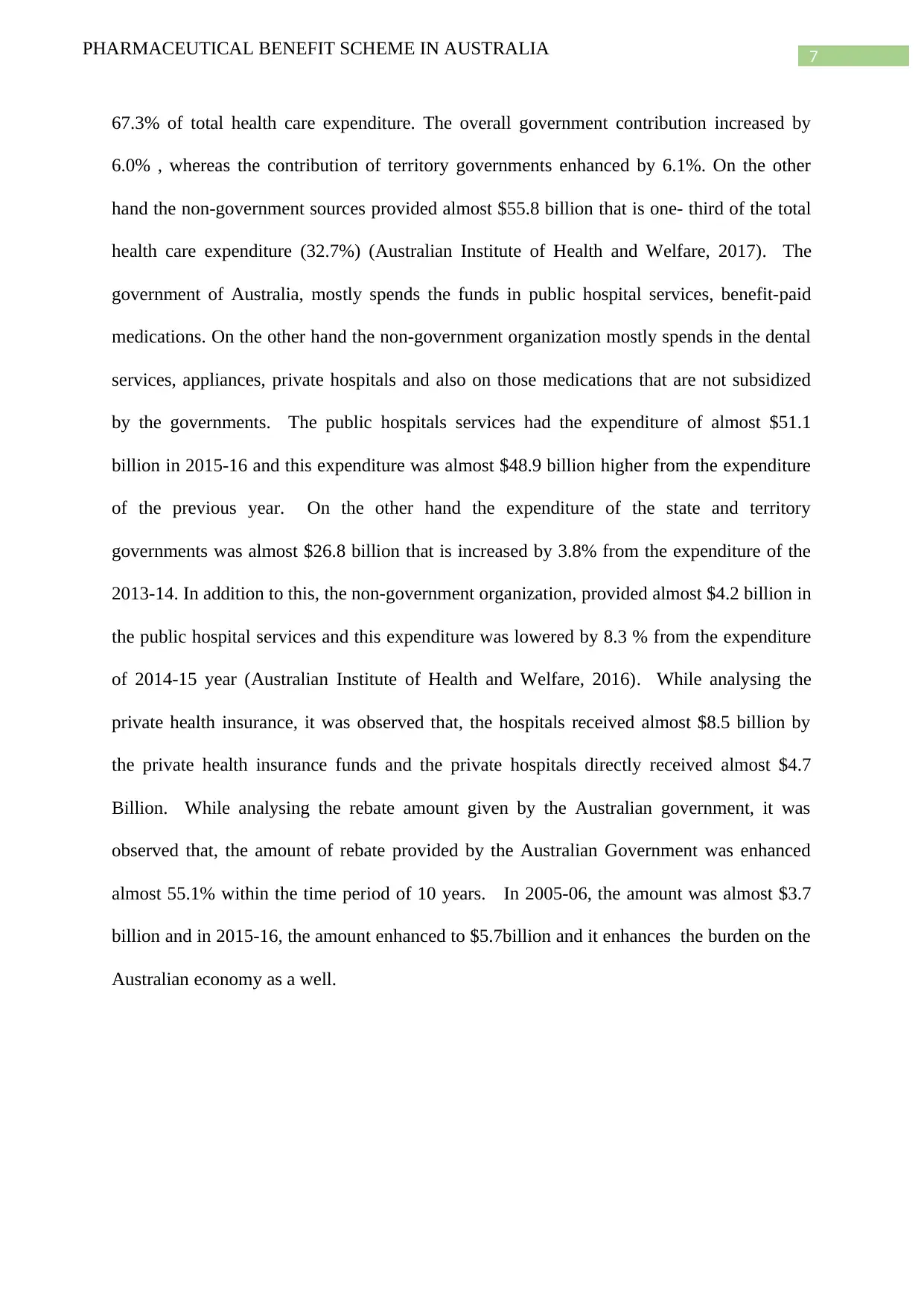
7PHARMACEUTICAL BENEFIT SCHEME IN AUSTRALIA
67.3% of total health care expenditure. The overall government contribution increased by
6.0% , whereas the contribution of territory governments enhanced by 6.1%. On the other
hand the non-government sources provided almost $55.8 billion that is one- third of the total
health care expenditure (32.7%) (Australian Institute of Health and Welfare, 2017). The
government of Australia, mostly spends the funds in public hospital services, benefit-paid
medications. On the other hand the non-government organization mostly spends in the dental
services, appliances, private hospitals and also on those medications that are not subsidized
by the governments. The public hospitals services had the expenditure of almost $51.1
billion in 2015-16 and this expenditure was almost $48.9 billion higher from the expenditure
of the previous year. On the other hand the expenditure of the state and territory
governments was almost $26.8 billion that is increased by 3.8% from the expenditure of the
2013-14. In addition to this, the non-government organization, provided almost $4.2 billion in
the public hospital services and this expenditure was lowered by 8.3 % from the expenditure
of 2014-15 year (Australian Institute of Health and Welfare, 2016). While analysing the
private health insurance, it was observed that, the hospitals received almost $8.5 billion by
the private health insurance funds and the private hospitals directly received almost $4.7
Billion. While analysing the rebate amount given by the Australian government, it was
observed that, the amount of rebate provided by the Australian Government was enhanced
almost 55.1% within the time period of 10 years. In 2005-06, the amount was almost $3.7
billion and in 2015-16, the amount enhanced to $5.7billion and it enhances the burden on the
Australian economy as a well.
67.3% of total health care expenditure. The overall government contribution increased by
6.0% , whereas the contribution of territory governments enhanced by 6.1%. On the other
hand the non-government sources provided almost $55.8 billion that is one- third of the total
health care expenditure (32.7%) (Australian Institute of Health and Welfare, 2017). The
government of Australia, mostly spends the funds in public hospital services, benefit-paid
medications. On the other hand the non-government organization mostly spends in the dental
services, appliances, private hospitals and also on those medications that are not subsidized
by the governments. The public hospitals services had the expenditure of almost $51.1
billion in 2015-16 and this expenditure was almost $48.9 billion higher from the expenditure
of the previous year. On the other hand the expenditure of the state and territory
governments was almost $26.8 billion that is increased by 3.8% from the expenditure of the
2013-14. In addition to this, the non-government organization, provided almost $4.2 billion in
the public hospital services and this expenditure was lowered by 8.3 % from the expenditure
of 2014-15 year (Australian Institute of Health and Welfare, 2016). While analysing the
private health insurance, it was observed that, the hospitals received almost $8.5 billion by
the private health insurance funds and the private hospitals directly received almost $4.7
Billion. While analysing the rebate amount given by the Australian government, it was
observed that, the amount of rebate provided by the Australian Government was enhanced
almost 55.1% within the time period of 10 years. In 2005-06, the amount was almost $3.7
billion and in 2015-16, the amount enhanced to $5.7billion and it enhances the burden on the
Australian economy as a well.
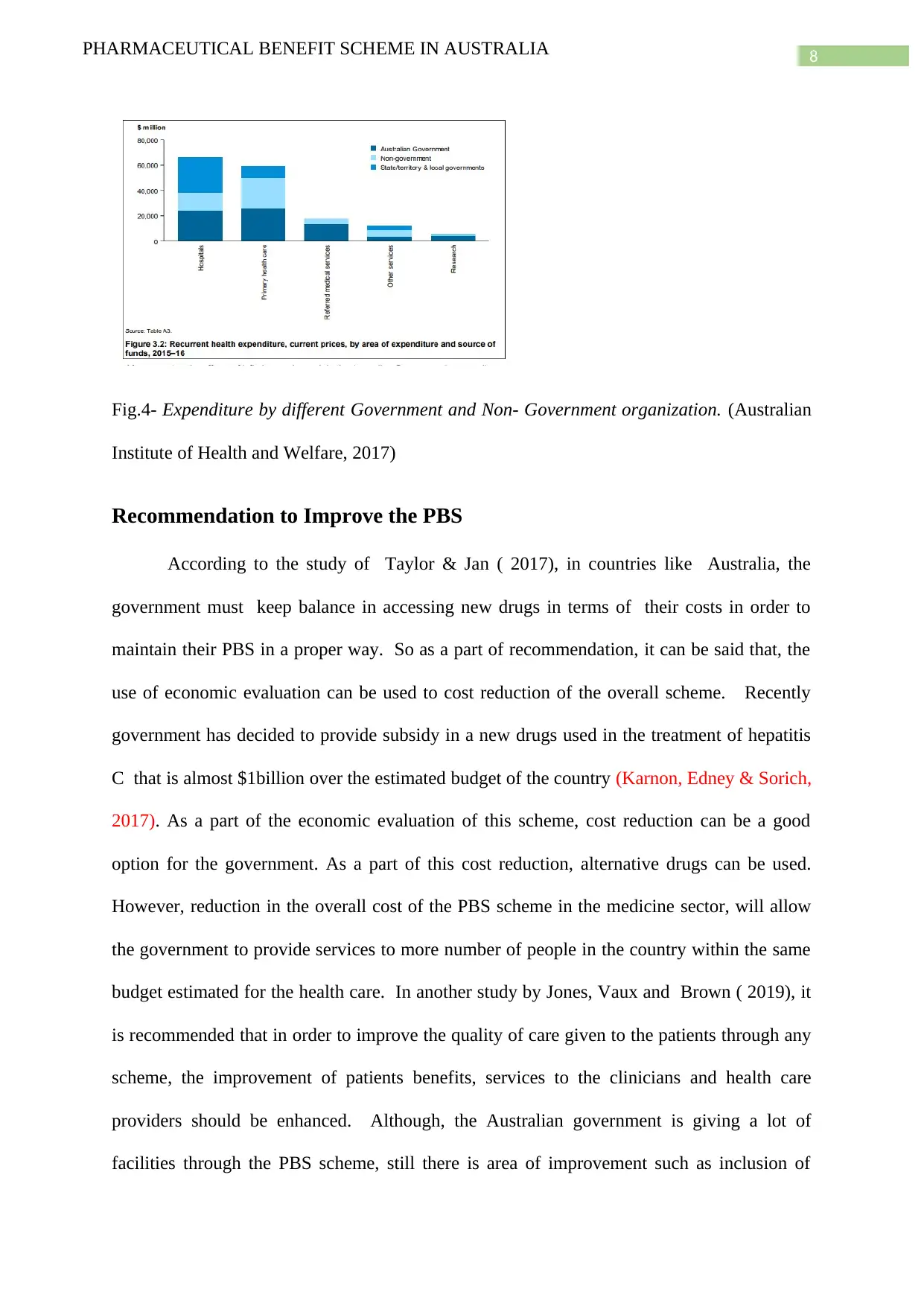
8PHARMACEUTICAL BENEFIT SCHEME IN AUSTRALIA
Fig.4- Expenditure by different Government and Non- Government organization. (Australian
Institute of Health and Welfare, 2017)
Recommendation to Improve the PBS
According to the study of Taylor & Jan ( 2017), in countries like Australia, the
government must keep balance in accessing new drugs in terms of their costs in order to
maintain their PBS in a proper way. So as a part of recommendation, it can be said that, the
use of economic evaluation can be used to cost reduction of the overall scheme. Recently
government has decided to provide subsidy in a new drugs used in the treatment of hepatitis
C that is almost $1billion over the estimated budget of the country (Karnon, Edney & Sorich,
2017). As a part of the economic evaluation of this scheme, cost reduction can be a good
option for the government. As a part of this cost reduction, alternative drugs can be used.
However, reduction in the overall cost of the PBS scheme in the medicine sector, will allow
the government to provide services to more number of people in the country within the same
budget estimated for the health care. In another study by Jones, Vaux and Brown ( 2019), it
is recommended that in order to improve the quality of care given to the patients through any
scheme, the improvement of patients benefits, services to the clinicians and health care
providers should be enhanced. Although, the Australian government is giving a lot of
facilities through the PBS scheme, still there is area of improvement such as inclusion of
Fig.4- Expenditure by different Government and Non- Government organization. (Australian
Institute of Health and Welfare, 2017)
Recommendation to Improve the PBS
According to the study of Taylor & Jan ( 2017), in countries like Australia, the
government must keep balance in accessing new drugs in terms of their costs in order to
maintain their PBS in a proper way. So as a part of recommendation, it can be said that, the
use of economic evaluation can be used to cost reduction of the overall scheme. Recently
government has decided to provide subsidy in a new drugs used in the treatment of hepatitis
C that is almost $1billion over the estimated budget of the country (Karnon, Edney & Sorich,
2017). As a part of the economic evaluation of this scheme, cost reduction can be a good
option for the government. As a part of this cost reduction, alternative drugs can be used.
However, reduction in the overall cost of the PBS scheme in the medicine sector, will allow
the government to provide services to more number of people in the country within the same
budget estimated for the health care. In another study by Jones, Vaux and Brown ( 2019), it
is recommended that in order to improve the quality of care given to the patients through any
scheme, the improvement of patients benefits, services to the clinicians and health care
providers should be enhanced. Although, the Australian government is giving a lot of
facilities through the PBS scheme, still there is area of improvement such as inclusion of
⊘ This is a preview!⊘
Do you want full access?
Subscribe today to unlock all pages.

Trusted by 1+ million students worldwide
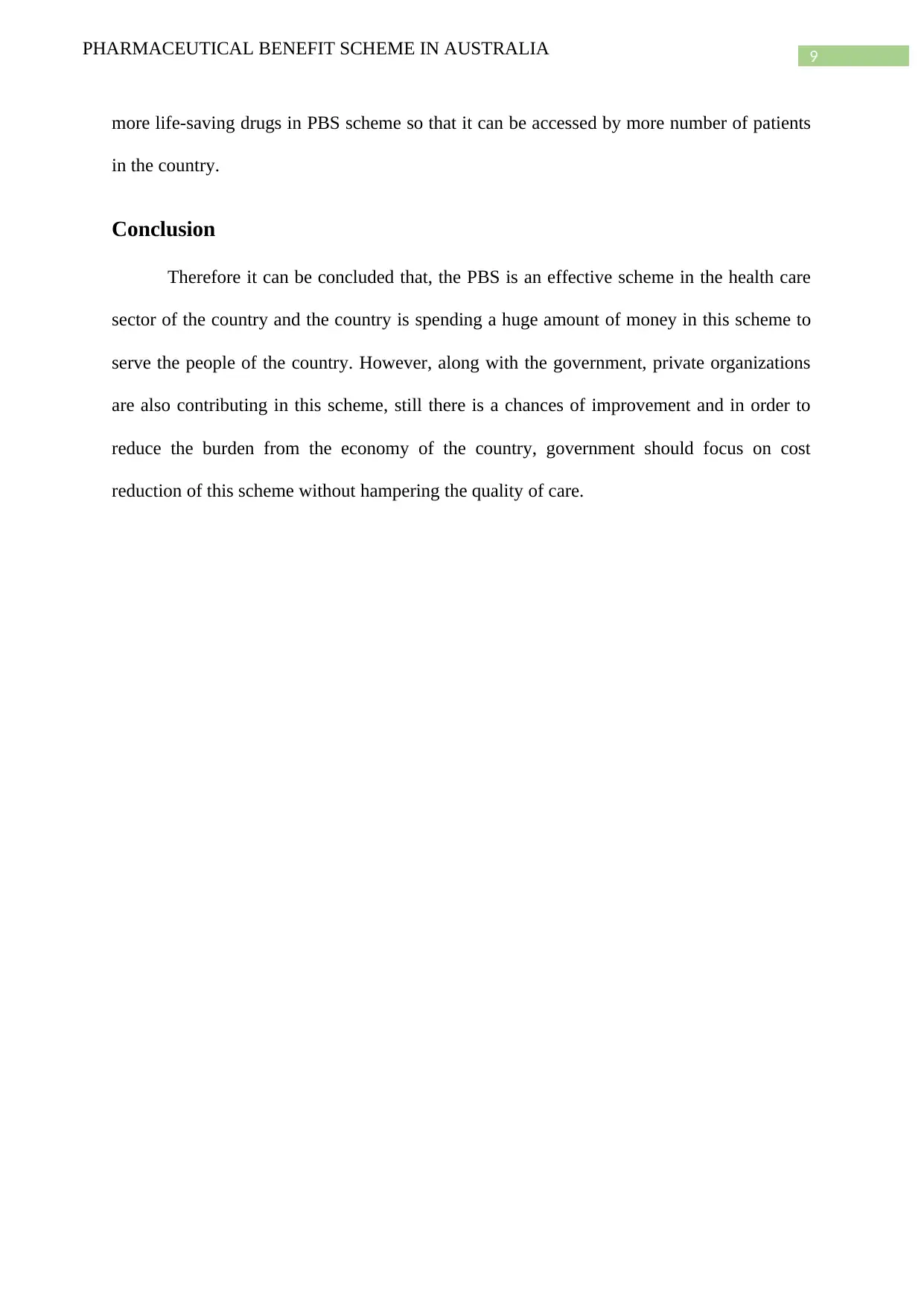
9PHARMACEUTICAL BENEFIT SCHEME IN AUSTRALIA
more life-saving drugs in PBS scheme so that it can be accessed by more number of patients
in the country.
Conclusion
Therefore it can be concluded that, the PBS is an effective scheme in the health care
sector of the country and the country is spending a huge amount of money in this scheme to
serve the people of the country. However, along with the government, private organizations
are also contributing in this scheme, still there is a chances of improvement and in order to
reduce the burden from the economy of the country, government should focus on cost
reduction of this scheme without hampering the quality of care.
more life-saving drugs in PBS scheme so that it can be accessed by more number of patients
in the country.
Conclusion
Therefore it can be concluded that, the PBS is an effective scheme in the health care
sector of the country and the country is spending a huge amount of money in this scheme to
serve the people of the country. However, along with the government, private organizations
are also contributing in this scheme, still there is a chances of improvement and in order to
reduce the burden from the economy of the country, government should focus on cost
reduction of this scheme without hampering the quality of care.
Paraphrase This Document
Need a fresh take? Get an instant paraphrase of this document with our AI Paraphraser

10PHARMACEUTICAL BENEFIT SCHEME IN AUSTRALIA
References
Australian Institute of Health and Welfare (2016). Health expenditure Australia 2014–15.
Health and welfare expenditure series no. 57. Cat. no. HWE 68. Canberra: AIHW.
Retrieved from- https://www.aihw.gov.au/getmedia/a13427b8-d5de-495d-8b8f-
4fd114f135d0/20279.pdf.aspx?inline=true
Australian Institute of Health and Welfare (2017). Health expenditure Australia 2015–16.
Health and welfare expenditure series no. 58. Cat. no. HWE 68. Canberra: AIHW.
Retrieved from- https://www.aihw.gov.au/getmedia/3a34cf2c-c715-43a8-be44-
0cf53349fd9d/20592.pdf.aspx?inline=true
Duckett, S.J. with Breadon, P., Ginnivan, L. & Venkataraman, P,. (2013). Australia’s bad
drug deal: high pharmaceutical prices. Grattan Institute, Melbourne ISBN: 978-1-925015-
00-3. Retrieved from-
https://grattan.edu.au/wp-content/uploads/2014/04/Australias_Bad_Drug_Deal_FINAL.pd
f
Jones, B., Vaux, E., & Brown, O., A. (2019). How to get started in quality improvement.
BMJ 2019;364:k5408.
Karnon, J., Edney, L., & Sorich, M. (2017). Costs of paying higher prices for equivalent
effects on the Pharmaceutical Benefits Scheme. Australian Health Review, 41(1), 1-6.
Retrieved from: http://www.publish.csiro.au/ah/ah15122
References
Australian Institute of Health and Welfare (2016). Health expenditure Australia 2014–15.
Health and welfare expenditure series no. 57. Cat. no. HWE 68. Canberra: AIHW.
Retrieved from- https://www.aihw.gov.au/getmedia/a13427b8-d5de-495d-8b8f-
4fd114f135d0/20279.pdf.aspx?inline=true
Australian Institute of Health and Welfare (2017). Health expenditure Australia 2015–16.
Health and welfare expenditure series no. 58. Cat. no. HWE 68. Canberra: AIHW.
Retrieved from- https://www.aihw.gov.au/getmedia/3a34cf2c-c715-43a8-be44-
0cf53349fd9d/20592.pdf.aspx?inline=true
Duckett, S.J. with Breadon, P., Ginnivan, L. & Venkataraman, P,. (2013). Australia’s bad
drug deal: high pharmaceutical prices. Grattan Institute, Melbourne ISBN: 978-1-925015-
00-3. Retrieved from-
https://grattan.edu.au/wp-content/uploads/2014/04/Australias_Bad_Drug_Deal_FINAL.pd
f
Jones, B., Vaux, E., & Brown, O., A. (2019). How to get started in quality improvement.
BMJ 2019;364:k5408.
Karnon, J., Edney, L., & Sorich, M. (2017). Costs of paying higher prices for equivalent
effects on the Pharmaceutical Benefits Scheme. Australian Health Review, 41(1), 1-6.
Retrieved from: http://www.publish.csiro.au/ah/ah15122
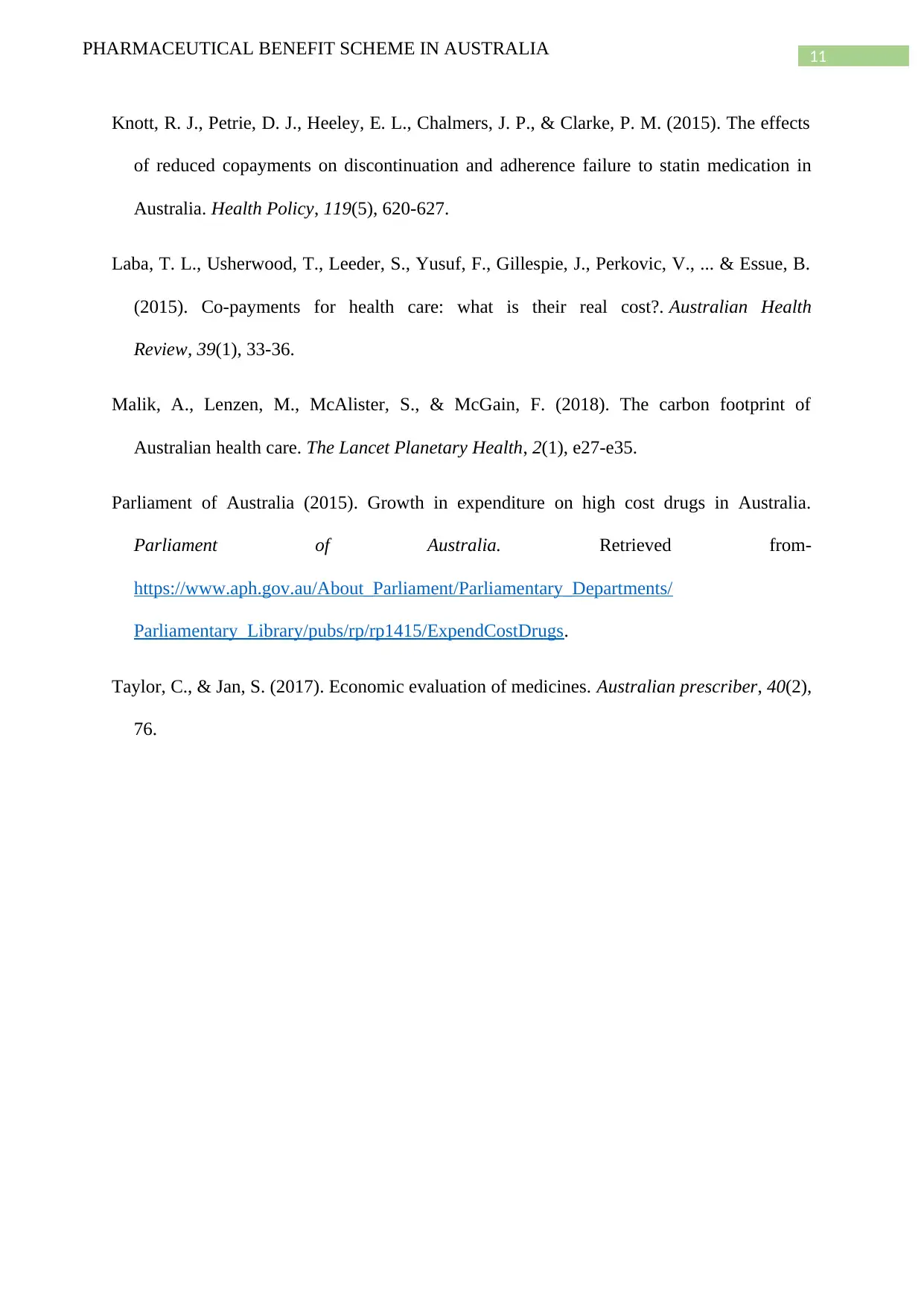
11PHARMACEUTICAL BENEFIT SCHEME IN AUSTRALIA
Knott, R. J., Petrie, D. J., Heeley, E. L., Chalmers, J. P., & Clarke, P. M. (2015). The effects
of reduced copayments on discontinuation and adherence failure to statin medication in
Australia. Health Policy, 119(5), 620-627.
Laba, T. L., Usherwood, T., Leeder, S., Yusuf, F., Gillespie, J., Perkovic, V., ... & Essue, B.
(2015). Co-payments for health care: what is their real cost?. Australian Health
Review, 39(1), 33-36.
Malik, A., Lenzen, M., McAlister, S., & McGain, F. (2018). The carbon footprint of
Australian health care. The Lancet Planetary Health, 2(1), e27-e35.
Parliament of Australia (2015). Growth in expenditure on high cost drugs in Australia.
Parliament of Australia. Retrieved from-
https://www.aph.gov.au/About_Parliament/Parliamentary_Departments/
Parliamentary_Library/pubs/rp/rp1415/ExpendCostDrugs.
Taylor, C., & Jan, S. (2017). Economic evaluation of medicines. Australian prescriber, 40(2),
76.
Knott, R. J., Petrie, D. J., Heeley, E. L., Chalmers, J. P., & Clarke, P. M. (2015). The effects
of reduced copayments on discontinuation and adherence failure to statin medication in
Australia. Health Policy, 119(5), 620-627.
Laba, T. L., Usherwood, T., Leeder, S., Yusuf, F., Gillespie, J., Perkovic, V., ... & Essue, B.
(2015). Co-payments for health care: what is their real cost?. Australian Health
Review, 39(1), 33-36.
Malik, A., Lenzen, M., McAlister, S., & McGain, F. (2018). The carbon footprint of
Australian health care. The Lancet Planetary Health, 2(1), e27-e35.
Parliament of Australia (2015). Growth in expenditure on high cost drugs in Australia.
Parliament of Australia. Retrieved from-
https://www.aph.gov.au/About_Parliament/Parliamentary_Departments/
Parliamentary_Library/pubs/rp/rp1415/ExpendCostDrugs.
Taylor, C., & Jan, S. (2017). Economic evaluation of medicines. Australian prescriber, 40(2),
76.
⊘ This is a preview!⊘
Do you want full access?
Subscribe today to unlock all pages.

Trusted by 1+ million students worldwide
1 out of 12
Related Documents
Your All-in-One AI-Powered Toolkit for Academic Success.
+13062052269
info@desklib.com
Available 24*7 on WhatsApp / Email
![[object Object]](/_next/static/media/star-bottom.7253800d.svg)
Unlock your academic potential
© 2024 | Zucol Services PVT LTD | All rights reserved.


